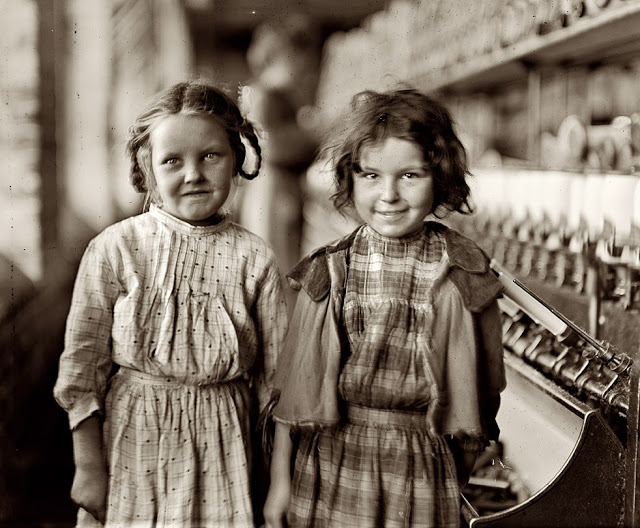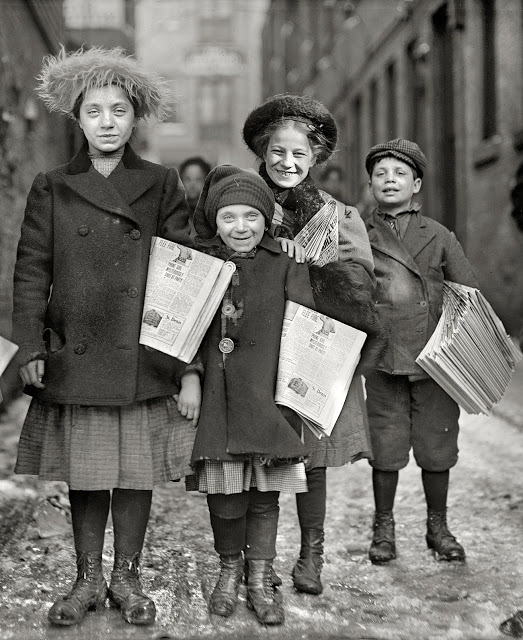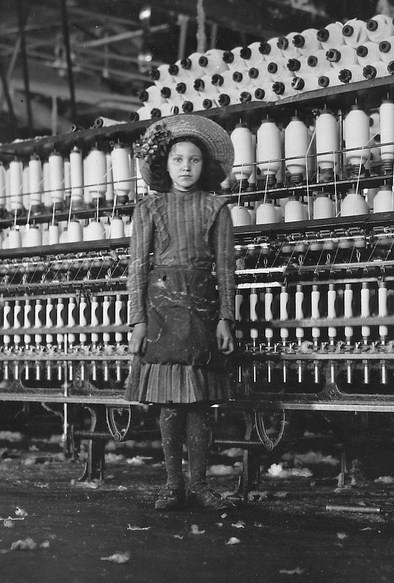Child Laborers
November 3, 2016

FASCINATING photos of children laborers at textile mills, farms, homes and on the streets of New York taken by photographer Lewis Wickes Hines in the 20th century were influential in bringing about child labor reform. A selection can be found at It’s About Time. Though some of the children pictured are bedraggled and dirty, they generally look healthy and decently dressed. Some are seen working alongside their mothers. Many went to school too and some are seasonal workers, picking short-term crops or shucking oysters. The girls look like girls and the boys look like boys. Many have an introspective look — maybe from the discipline and the time alone with their thoughts while working. These are intriguing photos.


— Comments —
John writes:
These are great pictures, but when thinking about the reality of child labor, it is important to remember that most factory workers came from farm families and entered the work force in the late 1800’s when industrialization was taking off. For this generation, having very young children involved in labor at home was considered perfectly normal, as was working 12 hour days or longer as long as the sun was up. The idea of quitting after 8 or 9 hours and going home when there was still work to accomplish would probably never have entered their minds. It was only in the impersonal and crowded atmosphere of the factories that people began no longer to think of themselves as independent agents with a job to accomplish, but as cogs in a wheel working to further enrich the already rich.
And speaking of child labor, here is a recording of a sonata composed by Gioacchino Rossini working at age 12 in 1802. Obviously he had better things to do in his youth than shuttling to and from soccer matches, and then coming home to eat pizza and play video games alone in his room––today’s “normal” way to raise children if you wish to avoid the wrath of Child Protective Services.
Laura writes:
It was only in the impersonal and crowded atmosphere of the factories that people began no longer to think of themselves as independent agents with a job to accomplish, but as cogs in a wheel working to further enrich the already rich.
Thank you. Good point. Manual labor isn’t necessarily bad for children. But dehumanizing manual labor is bad for them.
You forgot to include the link for Rossini.
(Being a child musician can be grueling too.)
John writes:
Sorry, I forgot yesterday to include the musical link. It runs well over an hour of composition. It’s hard to imagine this level of intense concentration in this age of 15-second attention spans, ADHD, etc.
Laura writes:
Thank you.
I understand what you’re getting at, but there are children giving that level of concentration to music today. They do exist. A subculture of intensely competitive and intense classical music training for the young still exists.
Paul A. writes:
Another thing that should be mentioned is that “Teen Age” is a pretty recent phenomena. Back then there was child and adult. There was no such thing as a teen-ager. And certainly no such thing as the extended adolescence lingering well into the thirties that you find so commonly nowadays.
Play was something for small children. As they grew, they had to take on more responsibilities. After puberty, play almost vanished, since the “child” had the mental and physical capability to contribute to his/her support and the support of their family.
To keep things in some perspective, Admiral David Farragut started his 60 year naval career at the age of nine when he was a midshipman. He “captained” his first vessel at the age of twelve when he was selected to bring a captured ship back to port. Lots more work and responsibility than shucking oysters.
Another bit of perspective is that the Code of Canon Law says a woman can wed at 14 and a man at 16. This presupposed that the sixteen year old could provide for a family, and that the 14 year old was capable of bearing and raising one.
Back then, the kids wanted the responsibility. Today? … That’s another story. I wonder what those pics would look like.
Laura writes:
It’s not really fair to say children don’t want that kind of responsibility when it is not even remotely possible for them or ever offered to them. Children have their own responsibilities today. In many cases, they have a tremendous amount of homework and they spend much, much more time in school. They probably have less time off than some of the children who were seasonal farm workers and part-time factory workers.
